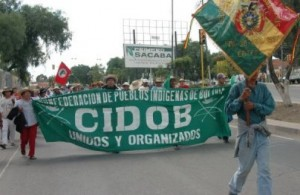Feb 22
20122
NED | National Endowment for Democracy, Non-Profit Industrial Complex, The International Campaign to Destabilize Venezuela, USAID
Chavez CIA Detabilization NED | National Endowment for Democracy USAID Venezuela
US Trojan Horses in Venezuela
Nil NIKANDROV | 20.02.2012
Strategic Culture Foundation
NGOs mushroomed in Venezuela after Chavez’s 1998 electoral triumph, and at the moment their number estimatedly reaches several hundreds. Back in 1998, the United States Agency for International Development (USAID) and the National Endowment for Democracy (NED) enjoyed unlimited freedom of maneuver in the country and made full use of it to expand the influence of the US intelligence community over the Venezuelan society. The correspondence of the US embassy in Caracas, unveiled by WikiLeaks, left no doubts that the US Department of State, the CIA, the US Defense Intelligence Agency, and DEA had been taking advantage of the situation to make inroads into Venezuela.
Washington had to learn as the 2002 anti-Chavez coup collapsed that the Venezuelan leader was a serious opponent who would not crack under pressure and at all times remained a clever strategist. Chavez managed to handle successfully the recurrent conflicts with the Empire, while staunchly upholding his socialist project domestically and building ever stronger positions internationally. Given Chavez’s record which includes oil sector nationalization and the expulsion of the fifth column from the petroleum industry, the removal of conspiracy-prone officers from the army top command, and nationally oriented socioeconomic reforms, plans for his ouster in a violent putsch obviously stand no chance, and Washington therefore has to place its bet on a color revolution in Venezuela. This type of revolt in the country does not seem altogether impossible as the support for the opposition in Venezuela typically measures around 35% and the Venezuelan middle class, students, and intellectual circles for the most part do not favor Chavez. These are the communities currently comprising the audience of the Venezuelan NGOs and receiving from them perks in the forms of grants, travel support, and costly gadgets. Color revolution champions are trained in Venezuela based on movies featuring the corresponding episodes from the recent East European history. As in Cuba, the white color is chosen as the hallmark of the Venezuelan protesters. What Venezuela’s NGOs must pretend to be oblivious to are Chavez’s achievements in fighting poverty, strengthening the national economy, and boosting the amounts of welfare for the population.
Naturally, Venezuela’s young are the NGOs’ main target audience. Student attack groups played the central role in the clashes between protesters and police in Venezuela in May, 2007 when the government revoked the license of the RCTV channel (the step was taken in connection with the fact that the RCTV broadcasting contract expired by the time). Chavez described the unrest as an attempt to overthrow the Venezuelan government and called the residents of low-income urban quarters and villages to resist what he termed a fascist offensive. In response, Andrés Bello Catholic University student leader John Goicoechea said that Chavez’ drumming up support among the more radical part of his constituency who were supposed to confront the violence-prone students was an irresponsible policy. Shortly thereafter, Venezuela’s state-run 8th TV channel demonstrated Goicoechea’s phone book with the US embassy phone and that of the US diplomat who worked with students. Goicoechea later stepped out of the spotlight, but there is surely still a place for him as a skilled color revolution activist in the CIA plans and we will see him stage a comeback. The US program of entraining students from affluent Venezuelan families stays on-line, though the tricks with white shorts, white paint on palms, etc. reflect a rather unimaginative attempt to replay past success stories.
NGOs like Provea, Cofavic, Centro de Derechos Humanos (in the Catholic University) Una Ventana a la Libertad, and Sinergia occupy the human rights advocacy niche. According to Chavez and his supporters, the groups, along with the opposition media, deliberately draw a distorted picture of what is happening in Venezuela, hammering just about every aspect of the country’s life, be it the situation within the army, the struggle against crime, the detention conditions, the workers’ employment terms, the environment, the Indian problems, etc. Activists from the above NGOs were spotted a number of times during transactions with CIA operatives who supply to them instructions and funds. The NGOs submit to the CIA lists of candidates for admission to courses teaching “self-defense” under the conditions of “instability”, which evidently means a provoked crisis.
The legitimacy of Venezuela’s electoral procedure is being permanently challenged. US puppeteers who used to say that Chavez had employed the national electoral council for ballot-rigging were instrumental in forming the NGO known as Sumate. María Corina Machado, a defeated candidate in the 2002 presidential race, headed Sumate in 2002. Predictably, she called into question the outcomes of essentially all elections and referendums in Venezuela, for example, that of the 2004 referendum in which Chavez smashingly won 60% of the vote. The image of Sumate suffered a heavy blow when it transpired that money – occasionally, tens of millions of US dollars – was fed to the group on a regular basis by NED. Chavez accused Sumate of conspiracy in the wake of the revelations. Machado personally met with US President G. Bush at the peak of her career, but her prestige was irreversibly eroded. In 2005, the Venezuelan office of the general prosecutor charged Sumate with exerting pressure on the authority and receiving funds from an organization controlled by the US Congress, but the case, after a series of re-openings, finally stalled in court.
The activity of NGOs in Venezuela continued completely unchecked over the first decade of Chavez’s rule, while the police and counter-espionage agency were constantly discovering that the confidants of the US and other Western countries in Venezuelan NGOs collected information of military importance across the country or surveyed its regions bordering Columbia, Brazil, and Guyana. It should also be noted that foreign intelligence services are keenly interested in Venezuela’s Amazonia, and environment-protection NGO activists are spying in the parts of the country formerly frequented by US preachers from the New Tribes Mission. Some 30 secret aerodromes in the zone of their activity were used to illegally carry out Venezuelan gold, diamonds, precious metals, and, according to several accounts, uranium. The latter circumstance may be paradoxically related to the concerns voiced by Bush’s and Obama’s Administrations over Venezuela’s allegedly existing secret uranium mines with Iranian workers on staff.
An end was put to the untamed activity of NGOs – the US Trojan Horses in Venezuela – in December, 2010 when the parliament of the country passed a law on the protection of political sovereignty and national self-determination. The legislation was backed by the ruling United Socialist Party (PSUV) and predictably met with resistance mounted by the opposition which actually thrives on foreign donations. By the law, groups are subject to sanctions for drawing money from abroad with the aims of destabilizing Venezuela or undermining the present authority. If caught red-handed, NGO activists would have to pay in fines twice the amount received from other countries or even face the loss of political rights for 5-8 years. Moreover, fines and deportation now await foreign nationals involved in funding subversive NGO activities in Venezuela.
With the financial transparency regulations for NGOs now in place, there is hope that the level of corruption in Venezuela’s politics will visibly go down, but it should be realized that the channels via which NED, USAID and their like pour millions of dollars into the country have not been fully severed. As noted by Eva Golinger, a person extremely knowledgeable about CIA operations against Venezuela, the easiest way to smuggle currency into the country is to have it delivered by diplomatic mail.
http://www.strategic-culture.org/news/2012/02/20/us-trojan-horses-in-venezuela.html








